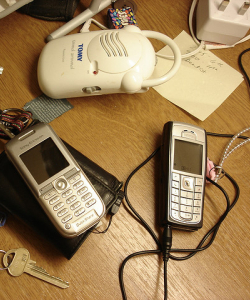
Nobody likes sifting through an overcrowded email inbox and deleting endless spam. We’ve all had that moment when we listen to a voicemail, hear a phone number, and race to find paper and pencil before our short term memeory forgets it. These days, we have more communication tools than we know what to do with.
In our personal lives, these tools are fun. People love showing off the cool new features and apps on their smartphones. Chatting has gone from being a novel phenomenon to being engrained in our lives with a number of different platforms available. In our work lives however, all these lines of communication can be hard to manage and to keep organized.
You could get to work one day to find a ton of emails to read, messages on your work phone or cell phone, memos from your boss and notes from a co-worker. Every new communication technology is another option for how to send each message. It’s time we rethink which medium is best for each type of message.
5 Communication Tools: Pros and Cons
Each communication tool has its pros and cons and each has its optimal use. When it comes to the workplace, where efficiency and clarity are of the utmost importance, choosing the right tool can make a world of difference. Each medium of communication has its own set of characteristics which will influence how they fit into your company.
Use email when there needs to be a record of the conversation. If there is information that is long, needs to be spelled or presented correctly or needs to be referenced in the future, use email.
Email is the best way to send exactly the same message to a large number of people. Be careful with Cc and Bcc lists and avoid spamming. Also clearly state what kind of respons you want in your email. If you want to make sure everyone has received your message, say so. If you don’t need that confirmation, say so as well. Nobody needs a dozen superfluous replies that just say “Got it!”
Phone
Calls are best for quick reminders and coordinating people and tasks in real time. Traditional phone calls might be falling by the wayside in the face of all the newer technologies but should not be forgotten completely.
Phone calls are personal and making sure to use the phone for a certain percentage of your communications can help maintain positive and healthy relationships. Over the phone, you are also less likely to have the confusion of tone that you get in text and chat.
Phone calls are also the best form of communication in urgent times. An “urgent” email might not be seen, let alone checked, for hours.
As more people use Skype or other video call technologies, it is important to consider video call etiquette too. Video calls are the most immediate, and also the most intrusive. If it isn’t a prescheduled video conference, send a quick chat message to make sure the other person is available and open to having a video-based conversation.
Voicemail
Leaving a voicemail is faster and easier than turning on your computer and composing an email but if you have a lot of phone numbers, addresses or names to leave, put down the phone and send an email instead. We all know it can be a hassle to scramble for a pen and paper while on the phone.
Not to mention, sound quality can be bad, things can get misheard, and names that are hard to spell can get completely lost in translation. Don’t make the recipient of the message have to listen to the voicemail over and over using voicemail menus, which can be annoying to navigate.
Text
Texting in the workplace is generally looked down upon, particularly because it requires the use of personal cell phones. Texting, however, can be an incredibly helpful tool if monitored.
Cell phones plus texting means people are reachable wherever they are. Phones can hold hundreds of messages, so conversations can be recalled far in the future. Texts aren’t time sensitive in the way phone calls are. Texts don’t need to be seen or answered right away which can be either a pro or a con.
If texting is going to be incorporated into your company, they can take the place of physical memos or notes and are especially useful for field-based staff like sales staff or on-site customer service reps. They are more permanent and as soon as one is sent, you can be sure that the recipient has got the message.
Intranets, Clouds and Beyond
Recently, a whole new explosion of tools for the instantaneous sharing of information has emerged. Establishing an intranet or collaborative software can mean a world of difference for your design or tech team, but don’t get seduced by all the hype of these shiny new toys for communication.
An intranet, internal social network, or cloud can be a great communication tool for departments that require a lot of collaborative work. For workplaces without that kind of need, they can be a distraction and a time-waster.
But if there is no legitimate need for one of these new technologies, you could just be making communication in your company even more chaotic. If you do choose to use one, make sure mission-critical functionality is emphasized over getting all the bells and whistles just for the sake of it.
—
It can be beneficial to reassess how people are communicating with each other in your workplace. Are you being as efficient as possible? Are your lines of communication a tangled and chaotic mess?
This list is not an end all, be all set. It is simply a reminder that each medium has its pros and cons. These pros and cons will be different for every company and for every industry.
How do you effectively use your communication tools? Share your tips!
Photo by Soctech via Flickr.
communication tools, communication tool, what are communication tools, pros and cons of using youtube as a customer communication vehicle, tools of communication, how do you decide what type of communication tool to use, using the phone effectively, how do you decide what type of communication tool to use?, Best Communication Tools, types of communication tools






Great post !
Email
I use emails to send massages to people that they need to know in the long run like
Skype
I use skype to notify people of mediate things like jumping out for a quick break
Then there are other forms of communication lke Basecamp which is best to notify everyone of a task completed and any feedback you may have on it
Hi Sphamandia, glad you liked it! (Sorry for the super-late reply…)
And I like your quick description on the ways you use email, skype & project management tools differently for different reasons. Keep communicating 🙂
Thank you for the great article about the pros and cons.
Communication Tracker is built with the goal of creating a central repository of communication for an organization. There it stands apart from other collaboration tools in that it tries to bring better organization to the communication which is 180 degrees opposite to increasing the chaos, as the article suggests.
We agree that users should not go for collaboration tools for their hype, but instead study what the tools offer to their organizations.
For further information, one may check out the tweets by @commtracker in August — a few are about what tangible benefits organizations can derive out of the tools.
Hi there – I took a quick look at your website. Very cool task communication tool! Best wishes for your business…have you found more success in particular industries e.g. creative, manufacturing, technology?
I’m looking for recommendations on communication tools and practices. I’m a coordinator for volunteers at local events. I’m building the group of volunteers and contacts who want informed when an event is scheduled. I started this last year for a specific event, and want to expand this for several events in our area. My experience last year was that most people who signed up to volunteer didn’t respond to emails, even when I asked them to. I found a few people primarily used texting to communicate. Very few answered calls or returned them. It was very difficult to know if people were receiving information I was sending, and almost impossible to get information back from them. I’m looking for an efficient and effective way to build a contact database, and communicate to those contacts using whatever form works best for them. For example some might choose email, some text, and some twitter. I don’t know if this is a good way to do this, or how to efficiently. Any recommendations?
Hi Jim,
A couple of things to consider as you decide which tool combo to use:
1) Ask your volunteers what would work best for them. Do a lot of them even hang out on Twitter?
2) How committed or engaged are your volunteers to begin with? If their level of commitment is low e.g. they signed up on a whim but don’t really intend to participate fully, then you have a bigger issue than what tool to use. You may want to make the volunteering opportunity more enticing for them somehow (I could share some ideas here but it’s beyond the scope of this article & comment).
3) How old are your volunteers? Are they comfortable with technology and do they spend any time online? If not, this may be why they’re not responding to email.
4) How did they register to become volunteers in the first place? The communication tool they used may end up being their preferred medium to receive ongoing communications.
I’m making some assumptions based on what you wrote, so I hope this answer helps in some way!
– Maya
This system has good reviews on the Internet and will be very useful for many users. We are a non-profit organization, and every day we face a lot of urgent work issues. Now we use the Corporate Telephone System with IP PBX http://www.teamwox.com free, and we can easily and conveniently. Maybe it will be a useful tool for communication?
Thank you.